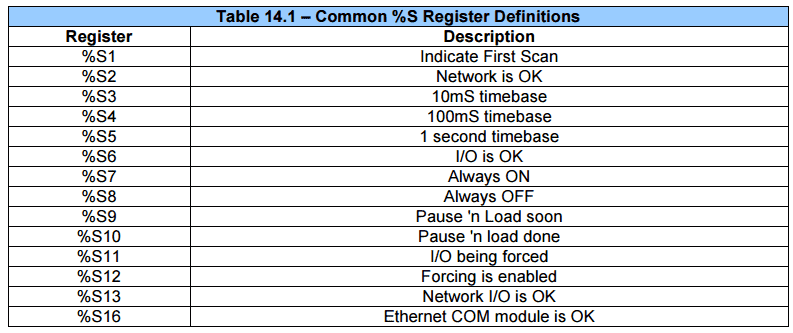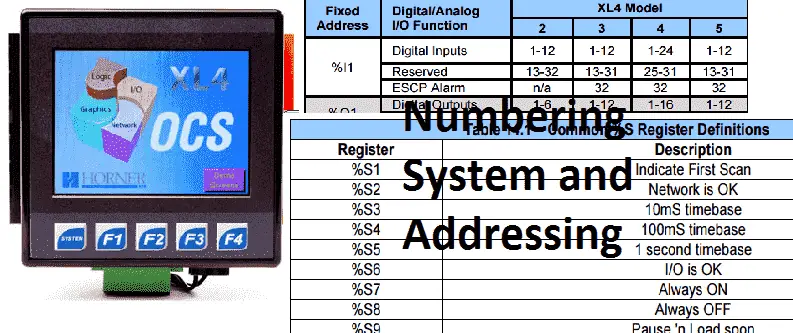We will now look at the Horner XL4 numbering system and addressing. Data is stored in different memory-type locations called registers. The registers can be either bits or words (16bit). Multiple registers can be used together to store a 32-bit value. (Double word) This all in one controller has several additional registers to handle some of the HMI communication. Let’s look at all of the areas in the controller.
Previously we discussed the following in our Horner XL4 Series:
System Hardware
Installing the Software Cscape
Cscape Software Setup
Establishing Communication
To better understand data types in the PLC you can get the free Understanding PLC Numbering Systems guide by subscribing to this site at the end of the post.
What Everybody Ought to Know about PLC Numbering Systems
Numbering System Notation – Horner XL4
Cscape uses the conventional method of addressing similar to other controllers.
%[type][offset]
% – required character
[type] – register type – R, I, Q, etc. see below
[offset] – this is the address of the register
Example: %R33
Note: You can also use [offset][type] for the format. So 33R is the same as %R33.
The following table will show the Register addressing types found in the Horner XL4 controller.
| Register Name | Bits | Description | Memory Retentive | Address Size |
| %AI Analog Input | 16 | Local Analog Input | No | 512 |
| %AQ Analog Output | 16 | Local Analog Output | No | 512 |
| %AIG Global Analog Input | 16 | Analog Input that come from the network. | No | 32 per ID |
| %AQG Global Analog Output | 16 | Analog Output that is sent to the network | No | 32 per ID |
| %D Display Bit | 1 | Digital output flags that will display the corresponding screen | No | 1023 |
| %I Digital Input | 1 | Local Input bit | No | 2048 |
| %IG Global Digital Input | 1 | Network Input bit | No | 64 per ID |
| %K Key Bit | 1 | Local Input bit from the front panel of the controller | No | 5 |
| %M Retentive Bit | 1 | Retentive single bit | Yes | 16000 |
| %Q Digital Output | 1 | Local Output bit | No | 2048 |
| %QG Global Digital Output | 1 | Network Output bit | No | 64 per ID |
| %R General Purpose Register | 16 | Retentive registers | Yes | 49999 |
| %S System Bit | 1 | Single bit predefined for system use | No | 13 |
| %SR System Register | 16 | Register predefined for system use | No | 192 |
| %T Temporary Bit | 1 | Retentive single bit | No | 16000 |
Note:
Address size will show the numbers that you can use to define the bit or register.
Example: %M1 to %M16000 – The Cscape software will notify you of an address that has been entered incorrectly.
Registry Map for Local I/O – Horner XL4
Each model of the Horner XL4 OCS will have a registry map for the local inputs and outputs. The following table is from the Horner manual showing the addresses of the local I/O.

Cscape will automatically assign the next available register if you enter a type and ‘?’. Example: I? will appear as %I0001. Enter I? again will appear as %I0002.
Note: You do not have to enter the ‘%’ every time you enter an address. Cscape will enter one for you.
System Bit Addressing – Horner XL4
The following is the system bit table. (%S) It contains useful information when programming the controller.

The following is the system register table. (%SR) Like the %S registers, this contains additional information when programming or monitoring the controller.



Additional information can be obtained by the on-line help in Cscape.
All of the documentation can be downloaded at the following URL:
https://hornerautomation.eu/product/xl4-prime-ocs-3-5-colour-touchscreen/
Next time we will look at the user interface.
Watch on YouTube: Horner XL4 Numbering System and Addressing
If you have any questions or need further information please contact me.
Thank you,
Garry
If you’re like most of my readers, you’re committed to learning about technology. Numbering systems used in PLC’s are not difficult to learn and understand. We will walk through the numbering systems used in PLCs. This includes Bits, Decimal, Hexadecimal, ASCII and Floating Point.
To get this free article, subscribe to my free email newsletter.
Use the information to inform other people how numbering systems work. Sign up now.
The ‘Robust Data Logging for Free’ eBook is also available as a free download. The link is included when you subscribe to ACC Automation.


